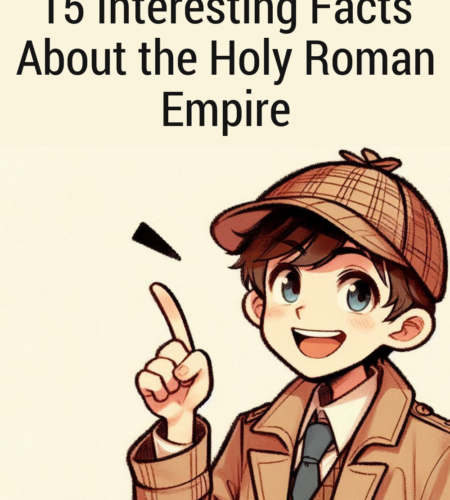The Holy Roman Empire, a historical juggernaut that spanned over a millennium, has left an indelible mark on European history. It was a complex web of territories, emperors, and fascinating developments. In this article, we’ll unravel 15 captivating facts about the Holy Roman Empire, shedding light on a world that was both perplexing and bursting with stories.
Fact 1: The Holy Roman Empire Wasn’t Holy or Roman
- Not Holy: Contrary to its name, the Holy Roman Empire was not especially “holy.” It was more a political entity than a religious one, with emperors often clashing with the papacy for power.
- Not Roman: Despite its grandiose title, the empire had little to do with the original Roman Empire. It emerged in the early Middle Ages, long after the fall of the Roman Empire.
- A Patchwork of Territories: The empire was a quilt of diverse regions, including parts of modern-day Germany, Austria, Italy, and more. It was a complex amalgamation of cultures and rulers.
Fact 2: The Empire’s Formation
- Charlemagne’s Influence: The empire’s roots can be traced back to Charlemagne, who was crowned Emperor of the Carolingian Empire in 800 AD by Pope Leo III. This marked the beginning of the Holy Roman Empire.
- Papal Authority: The Pope’s involvement in the empire’s formation was pivotal. The Pope’s blessing and support were essential for an emperor’s legitimacy.
- Lombard Connection: The Lombards, an Italian people, played a role in the empire’s creation by offering support to Charlemagne in exchange for his protection.
Fact 3: A Vast and Complex Territory
- Numerous Territories: At its height, the Holy Roman Empire consisted of hundreds of individual territories, each with its ruler. These ranged from powerful duchies to small city-states.
- The Imperial Diet: To maintain unity, the empire had the Imperial Diet, an assembly where rulers and representatives discussed policies and disputes. It was like a medieval version of a political summit.
- The Emperor’s Limited Power: The Emperor held authority over the empire, but this authority was often challenged by the various territorial rulers. The real power often lay in the hands of regional princes.
Fact 4: The Longest-Lasting Empire
- Over a Millennium of Existence: The Holy Roman Empire holds the record for being one of the longest-lasting empires in history, spanning from 800 AD to 1806 AD. It endured for more than a millennium.
- Ever-Changing Borders: The empire’s borders were in a constant state of flux, making it a dynamic entity that adapted to the shifting political landscape.
- End by Napoleon: The empire’s formal dissolution came at the hands of Napoleon Bonaparte, who abolished it in 1806.
Fact 5: The Holy Roman Emperors
- Elective Monarchy: The title of Holy Roman Emperor was not hereditary. Instead, it was an elected position, often chosen by a group of electors.
- Emperors vs. Popes: The struggle for power between emperors and popes was a recurring theme in the empire’s history. The Investiture Controversy, for instance, was a major conflict between them.
- Famous Emperors: The empire saw some renowned emperors, including Frederick Barbarossa, Charles V, and Charlemagne.
Fact 6: The Holy Roman Empire and the Papacy
- Papal Coronation: The Pope often played a significant role in the crowning of emperors. It was the Pope’s blessing that bestowed legitimacy upon emperors.
- Papal States: The Papal States, a region in Italy ruled by the Pope, were a constant source of tension between the empire and the papacy.
- Pope Gregory VII: The Investiture Controversy reached its peak during the papacy of Gregory VII, who excommunicated Emperor Henry IV.
Fact 7: Language Diversity
- A Linguistic Tapestry: The Holy Roman Empire was a tapestry of languages. German, Latin, and Italian were just a few of the languages spoken within its borders.
- Regional Variations: Different regions had their distinct languages and dialects, further emphasizing the empire’s complexity.
- German as the Dominant Language: As the empire progressed, the German language became increasingly dominant, particularly in the imperial bureaucracy.
Fact 8: The Legacy of the Holy Roman Empire
- Foundation of Modern Europe: The Holy Roman Empire played a pivotal role in shaping the political landscape of Europe and laid the groundwork for the modern nation-states.
- The Holy Roman Empire’s Impact on Art and Culture: The empire was a patron of the arts, with its rulers often supporting artists, architects, and scholars.
- Continued Influence: Even after its dissolution, the Holy Roman Empire’s legacy continued to affect the development of Europe.
Fact 9: The Empire’s Decline
- Political Fragmentation: As the empire aged, it became increasingly fragmented, with individual territories gaining more independence.
- Impact of the Reformation: The Protestant Reformation, led by figures like Martin Luther, further divided the empire along religious lines.
- The Thirty Years’ War: This devastating conflict, which lasted from 1618 to 1648, left the empire in ruins and weakened its central authority.
Fact 10: A Complex System of Government
- The Feudal System: The Holy Roman Empire operated on a feudal system, where lords and vassals had specific rights and responsibilities towards each other and the emperor.
- Power of the Prince-Electors: The prince-electors, a group of powerful nobles, held the key to electing emperors and were crucial figures in the empire’s politics.
- Patchwork of Laws: The empire had a diverse legal system, with each territory having its own set of laws and regulations.
Fact 11: The Empire’s Geographical Reach
- Varied Geography: The Holy Roman Empire encompassed a wide range of landscapes, from the mountainous regions of the Alps to the fertile plains of northern Germany.
- Cultural Diversity: The empire’s geography influenced the culture, architecture, and way of life in each region, leading to a rich tapestry of traditions.
- Influence on Modern Borders: The borders of modern European countries often reflect the boundaries of the Holy Roman Empire.
Fact 12: The Reformation’s Impact
- Martin Luther and the Reformation: Martin Luther, a German monk, played a pivotal role in the Protestant Reformation, which had a profound impact on the empire.
- Religious Wars: The Reformation led to a series of religious conflicts, including the Peasants’ War and the Eighty Years’ War.
- The Peace of Westphalia: The Peace of Westphalia in 1648 marked the end of the Thirty Years’ War and acknowledged the autonomy of many individual territories within the empire.
Fact 13: The Renaissance in the Empire
- Centers of Learning: The Holy Roman Empire had several centers of learning during the Renaissance, such as the University of Heidelberg and the University of Tübingen.
- Influence on Art and Science: The Renaissance in the empire saw flourishing developments in art, science, and philosophy, with figures like Albrecht Dürer and Copernicus making significant contributions.
- Renaissance Patronage: Emperors and noble patrons sponsored the work of renowned artists, contributing to the flourishing arts.
Fact 14: The Empire’s Symbolism
- The Imperial Eagle: The double-headed eagle was the emblem of the Holy Roman Empire, symbolizing the dual authority of the emperor in both religious and secular matters.
- Imperial Crown Jewels: The empire possessed a collection of regalia, including the Imperial Crown and the Imperial Sword, which were used in coronation ceremonies.
- The Reichsadler: The Reichsadler, a stylized version of the imperial eagle, remains a symbol of the empire’s heritage.
Fact 15: The End of an Era
- Napoleon’s Influence: The empire’s end came with the rise of Napoleon Bonaparte, who sought to reorganize Europe and establish a French-dominated order.
- The Confederation of the Rhine: Napoleon dissolved the Holy Roman Empire and replaced it with the Confederation of the Rhine in 1806, effectively ending its long history.
- Lasting Legacy: While the Holy Roman Empire may have ended, its legacy continues to captivate historians, and its impact on European history remains undeniable.
Conclusion
The Holy Roman Empire, with its intricate web of territories, emperors, and cultural diversity, stands as a testament to the complexities of history. Its legacy is deeply embedded in the formation of modern Europe, and the stories it tells are both perplexing and bursting with intrigue. The empire’s rise, fall, and enduring influence make it a subject of fascination for anyone interested in the rich tapestry of European history.
Subscribe to our email newsletter to get the latest posts delivered right to your email.




Comments